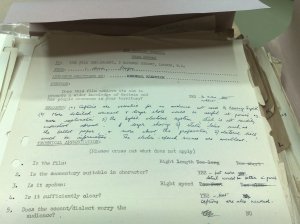So, as you know, I went to the National Archives, where I looked at three main British Council files. The first one contained a general history of the organisation’s film making. The second had more specific information about the 1946 handover of its film-making capabilities to the newly formed Central Office of Information.
The third – and most engaging – file contained reviews of individual films from British Council staff worldwide, written up in 1945 and 1946, and I’m going to begin by writing about that. Before going into detail, here’s a picture of one of the standardised review questionnaires that staff were asked to fill in:

A British Council film assessment questionnaire
Taken together, these questionnaires give very rich insight into what the films were intended to achieve, who watched them, and how they were received. I’m going to begin by pulling out some quotes which help illuminate that first point – just why were these films made and distributed?
The review questionnaires give us a very clear answer. In fact, the lead question, repeated on each, contains a very clear mission statement for British Council film making. It asks:
‘Does this film achieve its aim to promote a wider knowledge of Britain and her people overseas in your territory?’
For the most part, the various films reported on do achieve that main goal. What’s notable in particular is a strong sense of their very specific function as post-war propaganda. That comes through particularly well in these two quotes, which show the films working to correct both historic Nazi and (I suspect) more contemporary Communist propaganda:
London 1942: ‘The impression of London’s energy & vitality made a marked impression. The sight of the food available to the British People in 1942 interested some who remembered that Gt Britain was then supposed to be starving.’
E. A. S. Bullingworth, British Council Vienna, 9th May 1946
New Mine: ‘Good – valuable here (a mining country) showing progress does happen in the reactionary West.’
H Gardley-Wilmot, British Council Prague, 2nd November 1946
However, such propaganda could sometimes be too successful. Here’s an unknown British Council employee (he or she didn’t write their name on the form), who has had to deal with a rather disgruntled Greek audience:
Second Freedom: ‘Films of this type do more harm than good – presenting England as a Utopia where maternity homes, model schools, specialized training, employment under ideal conditions, are within everyone’s reach. Why not show food queues, the tiny meat and fat rations, housing shortage and other uncomfortable facts…The audience, believing the film gives a true condition of conditions in England, is dissatisfied with the absence of similar amenities in Cyprus.’
Respondent unknown, Nicosia Institute, 15th January 1946
And sometimes, of course, the films are either heartily disliked – Gardley Wilmot of Prague comments that Local Government ‘seems meant for mental age 14’ – or bafflingly irrelevant. D. S. A. Adams, of the British Legation in Kabul, when asked whether Life Cycle of the Newt helped promote wider knowledge of Britain and its people, responded:
‘NO! My dear sir…’
R. Wye, Jerusalem’s 1945 Functional Officer, was similarly puzzled to be asked about the propagandistic effectiveness of King Penguins, quite reasonably pointing out that ‘penguins are not particularly British’. He had other problems too:
‘I am cutting a little of the love scene between two penguins. It just goes far enough to produce raucous guffaws.’
In general, however, the films do seem to have been very successful. They were thematically varied, and both reached and entertained very diverse international audiences. But who were those audiences? The questionnaires reveal much about them, too; too much, in fact, to share just now, so they will be the subject of my next post.
Filed under: film archive | Tagged: 1945, 1946, british council, C.O.I., Central Office of Information, counterpoint, National Archives, post-war, propaganda, tuttle | Leave a comment »


